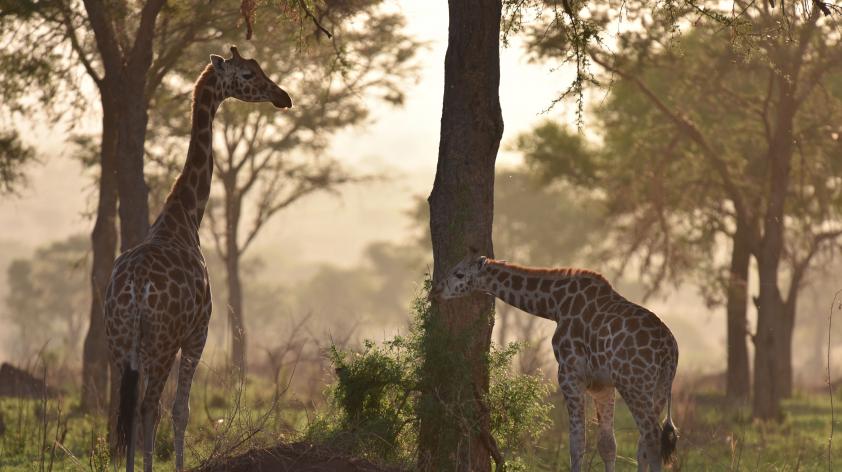
Taking Giraffe Conservation to New Heights and Places
Of the four species of giraffe found in Africa (Masai, Northern, Reticulated and Southern), the Northern giraffe’s range is by far the most fragmented, with many remaining populations restricted to disconnected National Park islands.
Because of this, for these giraffe, conservation efforts are focused on reducing threatsto the remaining populations while also expanding their range through translocations and re-introductions into areas where they were wiped out. This is only done when the conditions and security have improved to the extent that such re-introductions are feasible. For example, see our recent blog about rewilding efforts in Niger.
Conservation research is a key part of these efforts, particularly monitoring populations, and following the movements of giraffe via satellite tracking units. This allows us for the first time to understand the habitat and space that is needed by these giraffe in order to survive, as well as how they move between areas across seasons.
The Northern giraffe conservation efforts are lead by SDZG’s close partners the Giraffe Conservation Foundation (GCF) in concert with country governments. In March, SDZG helped fund and implement vital conservation research activities in Uganda for the Nubian giraffe (formerly Rothschild’s giraffe), a sub-species of the northern giraffe. Both Jenna and Dave travelled to Uganda to assist GCF and the Uganda Wildlife Authority (UWA) on the ground with the operation. GCF has a long-standing partnership agreement with UWA to support all giraffe conservation and management in Uganda.
In 2018, the Nubian giraffe was assessed by the International Union for Conservation of Nature (IUCN) and listed as ‘Critically Endangered’ with an approximately 80% population decline in the last three decades. Giraffe populations (and all wildlife) suffered a huge decline in Uganda during the 1970’s into the early 2000’s largely due to illegal hunting throughout the Idi Amin and Lord’s Resistance Army eras.
Uganda is home to over half the population of Nubian giraffe in the world, currently divided between Murchison Falls National Park, Kidepo Valley National Park, and Lake Mburo National Park. Murchison Falls National Park, Uganda’s largest park located in the north west section of the country on the border with the Democratic Republic of the Congo and bisected by the iconic Nile River, holds the largest population of Nubian giraffe in the country – the majority of the giraffe (approximately 1,500 individuals) are confined to the northern bank of the park.
Kidepo Valley National Park on the other hand, is home to approximately 61 Nubian giraffe and is a true example of the positive steps Uganda has taken for giraffe conservation as this specific population dropped to five individuals by 1995.
Lake Mburo National Park hosted Uganda’s first (re)introduction of 15 giraffe in 2015 and now support a growing population of 24 individuals. All wildlife populations have rebounded in the past decade due to Uganda’s dedication to wildlife conservation, yet still face significant threats including illegal hunting (poaching), habitat degradation, and human encroachment.
The operation in March was focused on three protected areas: Kidepo Valley National Park, Murchison Falls National Park, and Pian Upe Wildlife Reserve (see map)
Kidepo in the very northern reaches of Uganda and bordering South Sudan, is a true wildlife gem. Despite the instability across the border, wildlife and giraffe in the southern half of the park are thriving. Here, we were able to attach solar powered satellite tracking units, known as ossi-units (for more information, see this short video) to two males and three females.
These units will record the giraffes' location at hourly intervals for at least two years. Knowing their movements is key not only for informing conservation, but also to help anti-poaching rangers better deploy their resources and patrols. Already these units have proved their worth, documenting the first movement of one giraffe, a male named Luca, into South Sudan for a short time before returning to the safety of the park.
For the same reasons, in the roughly 950-acre Murchison Falls National Park, on the north bank, we also attached 15 ossi-units to three male and 12 female giraffe. These giants will provide vital data for conservation for several years.
This tracking research is part of a larger collaborative initiative called TWIGA TRACKER between SDZG, GCF, Senckenberg BiK-F, and Smithsonian Conservation Biology Institute.
TWIGA TRACKER is a groundbreaking program that aims to track 250 giraffe across the African continent in key populations of the 4 giraffe species. This will be key in filling the current knowledge gaps we have for giraffe which is hampering effective giraffe conservation efforts on the ground.
Surprisingly, for such a large, famous and iconic animal, we know very little about the giraffe, including their movements. TWIGA TRACKER tackles this head-on.
In addition to the vital monitoring work conducted, we also travelled to eastern Uganda near the Kenyan border to conduct a recce survey of the remote Pian Upe Wildlife Reserve, as it is a candidate for re-introduction of giraffe later this year.
Historically there were giraffe in Pian Upe, but they were wiped out by poaching just within the last few decades. The last giraffe seen in the reserve was in 1996, however, now with the security situation improving and after assessing the habitat, we believe that giraffe populations can be reestablished and flourish here once again. Watch this space.
San Diego Zoo Global is the only zoo in the world to establish an on-the ground giraffe conservation and research program in Africa: the Twiga Walinzi initiative in Kenya focused on the reticulated giraffe. Additionally, as funding and resources allow, SDZG works closely with GCF and other partners on conservation efforts for two other giraffe species Maasai and northern across several countries.
Please note: the map credit is Michael Butler Brown, GCF. All photo credits are Philip Carter.













